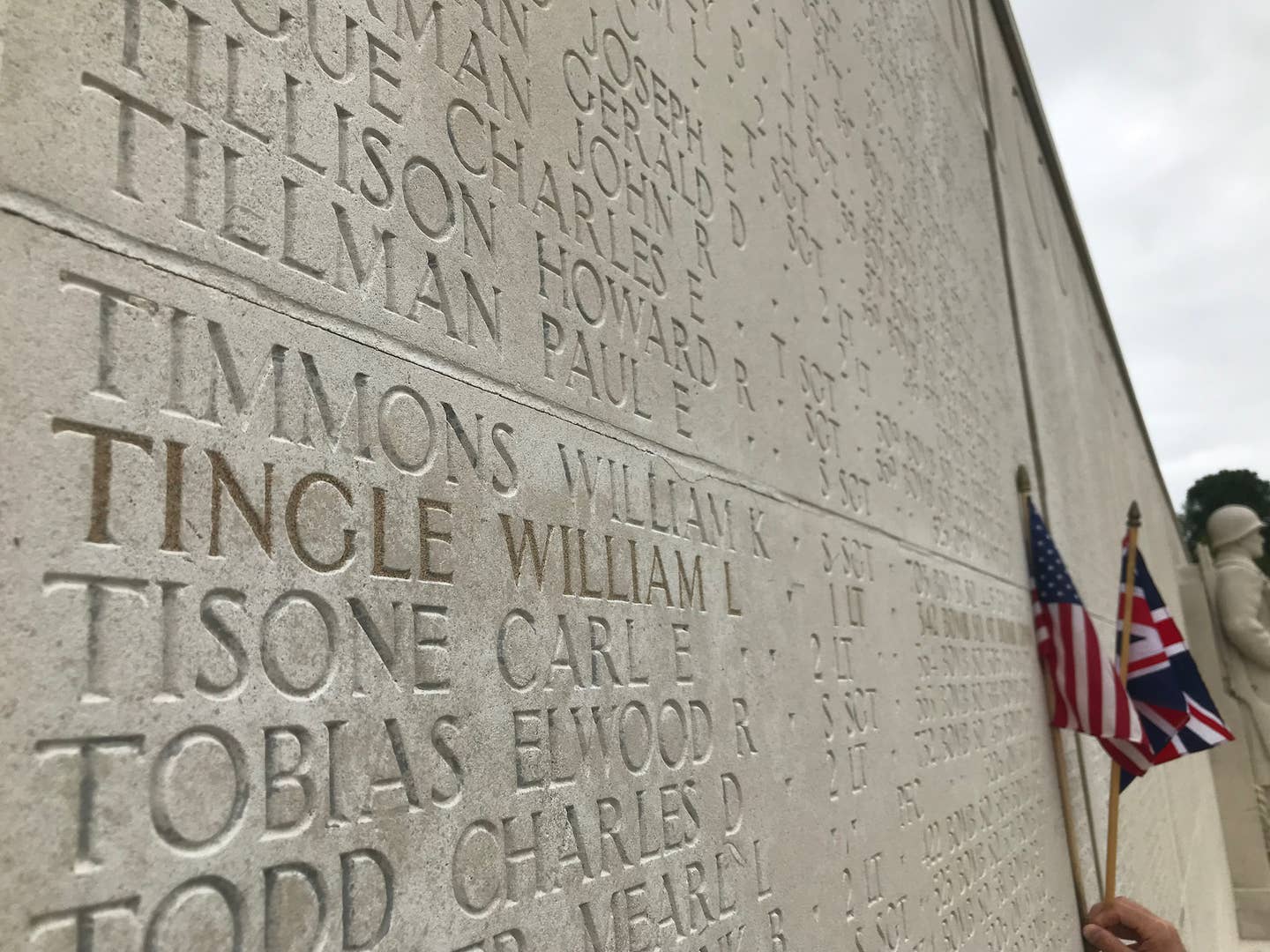A War-Torn Tale
Military service has always been a big part of my family’s heritage—and no doubt many others can relate. Learning more about the heroic and tragic story of one of my…

W.L. Tingle name on CAC&M wall. [Photo: Courtesy of Nanis GIlmore]
Military service has always been a big part of my family’s heritage—and no doubt many others can relate. Learning more about the heroic and tragic story of one of my distant cousins—William L. Tingle—recently has provided an added boost to that sense of pride.
Both sides of my family can boast their fair share of those who nobly served our nation in the armed forces. My late father was extremely proud of that fact, even though he wasn’t a veteran himself. The closest he came was being a member of the Corps of Cadets at Texas A&M University. My paternal grandfather, a Jamaican-born immigrant, served in the U.S. Army during World War I. After Pearl Harbor, my maternal grandfather ran away from an orphanage with his younger brother, lied about his age, and joined the U.S. Army Air Corps, serving in the Asiatic-Pacific Theater as a staff sergeant.
My dad told me that one of my cousins from my grandmother’s Colorado-rooted side of the family served as a Naval aviator aboard the USS Hornet. I also had a great uncle on my mother’s side who served in the Navy during WWII. Another uncle—like myself and my father, a proud A&M graduate—flew as a navigator on a WWII bomber and recorded more than 100 missions in Korea and Vietnam.
Given my family’s military background—which, by the way, has made holidays like Memorial Day and Veterans Day resonate more keenly in recent years—it’s no surprise my dad proudly told me about William L. Tingle, who went by Bill.
Since my father was born in 1941, he never knew his first cousin Bill, a copilot on a B-17 Flying Fortress, one of the most famous heavy bombers in history and a major factor in winning WWII. His airplane was shot down over Nazi-occupied France in 1942. Of the crew of 10, only four survived—and Tingle was not among them. I don’t recall much more than that, other than seeing his parents’ graves next to that of my father, grandparents, and my dad’s brother. I never gave him much thought when visiting the family plots at our south-side cemetery in San Antonio. That’s probably because I never realized Bill Tingle’s body, like so many who served in WWII, was never recovered from his ill-fated final mission.
According to Defense POW/MIA Accounting Agency documentation, on October 21, 1942, First Lieutenant Tingle was aboard a B-17, the Francis X—named after the pilot, Second Lieutenant Francis X. Schwarzenbek—that took off from the British Royal Air Force Base in Polebrook, England, as one of 99 aircraft on a mission to destroy German submarine bases in Lorient, France. Only 18 of those bombers made it to the target because the rest were forced to turn back because of heavy cloud cover over the target. Tingle and Sergeant George Whitham Jr. were actually filling in for two members of Schwarzenbek’s crew.
Witnesses on the same mission said the Francis X was hit by enemy fire from a Focke-Wulf 190 fighter, fell out of formation, and went down in the Bay of Douarnenez. Four crewmembers managed to bail out and survived but were captured. The remains of the other six, including Tingle, were never located or identified because the heavy presence of German forces in the area prevented any search efforts. Postwar attempts to find the airplane’s actual crash site along its route, or any remains of the missing crewmembers, also proved unsuccessful.
I know all of this detail thanks to Nanis Gilmore.
In 2019, Gilmore, a 72-year-old retired registered nurse living in Vancouver, Washington, emailed me to ask if I was related to William L. Tingle. She informed me that her mother, the former Charlotte Elizabeth Teepell, married Bill Tingle in Tampa, Florida, in February 1942, just before he shipped out to England. Bill was killed a mere eight months later at the age of 25, leaving Charlotte a 27-year-old widow.
After Charlotte suffered a stroke in 2007, the family decided to move her to a care facility. In preparation for that, Gilmore was going through her mother’s belongings when she came across a box of love letters Charlotte received from Bill during the war. All the envelopes were addressed to Mrs. William L. Tingle, and the letters—all 71 of them—were neatly stowed away along with some other keepsakes, telegrams, and photo albums. When she was a teenager, Gilmore recalls stumbling across an 8-by-10-inch framed photo of Bill in uniform in a desk drawer and asking her mother, “Mom, who is this handsome man?”
“[She was] fumbling a little bit [to answer] because she really hadn’t mentioned him before…[and said,] ‘Well, he was my first husband. He died in the war,’” said Gilmore, whose father, Merrill Gilmore, married Charlotte about five years after Bill’s death. “…It was hard for Mom to talk about. I think it speaks volumes that she carried that box of letters her entire life.”
It’s undoubtedly a common occurrence for those who represent what’s been aptly dubbed the “Greatest Generation.” There must have been untold instances of marriages taking place just before the soldier was called off to war.
One of the Francis X’s survivors, Sergeant Ned Herzstam, wrote a letter to George Randolph Tingle—Bill Tingle’s father and my great-great-grandfather—that Gilmore has graciously shared with me. The correspondence included a rough drawing of the B-17 crew positions aboard the aircraft.
“As you see [from the diagram], Bill had a [more] difficult escape passage than myself, [the] radio operator,” Herzstam said in his letter dated July 23, 1945. “However, the bombardier [Lieutenant Harry R.] Erickson survived and he reported that Bill was putting on his parachute, but had not started for the escape hatch at the time…Erickson bailed out. That is the only visual report there was about Bill. However, I believe I talked with him last as I was one of the last to leave the ship, and he was still there when I left. Mr. Tingle, your son was a real soldier and one of the few real officers it was a pleasure to serve [with]. I heard him talk under fire, and there was no trace of fear in his voice, always calm assurance. The last words I heard him say were, ‘We’re turning back for England.’…
“I landed about 5 miles offshore and was fortunate enough to be picked up by a French fishing boat. Of the five men that went out of my escape door, three lived [and] two drowned. By my diagram, you can see five go out the front hatch…of those five front men, only one is back home now, [Lieutenant] Erickson…and he told me he did not know if the other four ever got out of the ship. So Mr. Tingle, it is impossible to determine if Bill went down with the ship, drowned after parachuting, or was taken POW. Only one thing more, wherever he is now, rest assured you can always be proud of him. I am!”
Gilmore said Charlotte, who was living in Boston at the time of her husband’s last mission, went to live with Bill’s parents in San Antonio not long after he was declared missing in action to share in their grief.
“[My husband, Philip, and I] visited the house [at 201 Cloverleaf Avenue in March 2018] and sat outside with the current owner and chatted for quite some time,” she told me in one of the many emails we have exchanged about Bill and Charlotte’s brief life together. “He remembered the Tingles.”
Tingle’s name is enshrined on the Wall of the Missing, along with more than 5,000 MIA men and women—most of whom died in the Battle of the Atlantic or the strategic air bombardment of northwest Europe—at the Cambridge American Cemetery and Memorial in England. My father had a marker erected for Bill at Fort Sam Houston National Cemetery in San Antonio. Gilmore also shared with me the letter my father sent to her mother in 2003 to deliver that special news.
Inspired by her mother Charlotte, who died at age 94 in 2009, and Bill’s incredible love story, Gilmore visited the Cambridge memorial with her husband in 2019.
“The wall stretches a block in length,” Gilmore said. “It was, for me, overwhelming to see the names plus all the crosses in the field and to realize the enormous sacrifice made to win the war. It was an emotional experience when the superintendent of the memorial took us to where Bill’s name was on the wall and handed me an American and British flag [to take photos with].”
At Gilmore’s urging, my cousin Dr. Leslie E. Tingle, also an A&M alum and the eldest son of the decorated Air Force officer and late uncle, and I have submitted DNA samples to the Department of Defense Family Reference Database for use in the Armed Forces DNA Identification Laboratory. It’s a service the government provides so that in case any remains are ever discovered during excavations of Europe’s beaches and battlefields, Bill Tingle might be able to be identified. According to the Defense POW/MIA Accounting Agency, more than 72,000 service members remain unaccounted for from the WWII era.
“The journey to find Bill has been fascinating and very emotional at the same time,” Gilmore said. “I know my mom and Bill are together now, and I’d like to think that this search is somehow meaningful for them too.”
Before enlisting in 1941 and earning his wings at Brooks Field in San Antonio, Bill Tingle was “studying voice in Boston,” according to a three-paragraph article in the October 29, 1942, San Antonio Evening News with the headline: “1st Lt. W.L. Tingle Reported Missing in Action.” It was in Boston where Bill and Charlotte first met in 1941 as voice students, started dating, and fell in love.
It didn’t take me long to realize the little fact about “studying voice” near the end of the newspaper story helps to explain the closing of Herzstam’s letter to Bill’s father. It was clearly a nod to my distant cousin’s love for music and singing. In one of his final letters to Charlotte, Gilmore said he told his wife that he even led his bomber group—in need of a morale boost—in song because a scheduled vaudeville troupe was late for its performance.
“Well, I’ll end now with a thought [from a Christian Science hymnal] that proved helpful to me: ‘O’er waiting harpstrings of the mind, there sweeps a strain, low, sad, and sweet, whose measures bind the power of pain and wake a white-winged angel throng of thoughts illumined by faith and breathed in raptured song with love perfumed.’ A lot of Bill’s life was devoted to song and I’m sure he’d want you all to carry on this singing. — Respectfully, Ned”
Respectfully, indeed. Rest in peace, Bill and Charlotte.
Editor's Note: This story originally appeared in the November 2023 issue of Plane & Pilot magazine.

Subscribe to Our Newsletter
Get the latest Plane & Pilot Magazine stories delivered directly to your inbox






